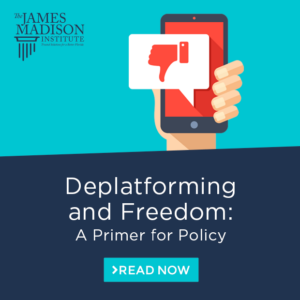By Andrea O’Sullivan
Click here to read the full study, “Deplatforming and Freedom: A Primer for Policy”
Click here to read a condense summary of “Deplatforming and Freedom: A Primer for Policy”
The yearning for freedom is in America’s DNA. It always has been: some 200 years ago, the French liberal political philosopher Alexis de Tocqueville examined how the new nation’s unique character oriented towards local self-governance and voluntary association[1] in his classic work Democracy in America.[2] In contrast to the centralized administration that characterized many European states, the United States of America adopted a federated system where power was limited to as local a level as possible.[3] This intentional separation of powers and retention of rights and authority to the lowest practicable level helped create a democratic culture where government was both responsive to the people and respectful of their desire for liberty.
A lot has changed over the past two centuries, not least of which is the size of our central government, which has regrettably grown considerably. Long gone are the days when government outlays constituted some single-digit percentage of US GDP as it was in the early 20th century; today, government expenditures of almost a quarter of total GDP are more common (to say nothing of our federal debt).[4]
Technology, too, has changed quite a bit, and has allowed us to be much more productive. Total factor productivity, a measure of how much economic output is produced given a set amount of labor and capital, increases in tandem with the returns to technological innovation.[5] Gains from innovation have allowed us to enjoy more material wealth than could have been dreamed of in the days of de Tocqueville.
Yet paradoxically, technologies can be a tool of control just as they can be a means to secure freedom.[6] Indeed, it is no coincidence that the size of government increased at the same time that technologies allowed new scales and records in production.[7] Not only does technology allow more production, which creates more wealth that the government can tax, it also can provide the means for governments to better surveil and clamp down on private activities. For example: it is much easier to spy on digital communications with the click of a computer mouse than it is to physically search millions of pieces of postal mail.
The rise of online platforms extends the paradox that technologies can serve as tools of both liberation and control. Social networking and matching services have made it easier than ever to connect with others, create and share content, and develop our own audiences and even livelihoods online. At the same time, the companies that run these platforms have the power to allow or disallow connections at their own discretion.
Whether exercised on behalf of governments, private activists, or their own whims, platforms’ content controls have limited individuals’ abilities to connect and communicate in the ways they desire. In extreme cases, users and even competing applications find themselves “deplatformed,” or cut off from connectivity, by service providers for actions that are fully legal. Worryingly, deplatforming can occur to stifle certain points of view.
[1] Leonard P. Liggio, “Tocqueville and Self-government,” Online Library of Liberty, Literature of Liberty: A Review of Contemporary Liberal Thought, Spring 1982, vol. V, no. 1: https://oll.libertyfund.org/page/tocqueville-and-self-government.
[2] Alexis De Tocqueville, Democracy in America, New York: G. Dearborn & Co., 1838, https://www.gutenberg.org/files/815/815-h/815-h.htm.
[3] George Carey and James McClellan, eds. The Federalist. Indianapolis, IN: Liberty Fund, 2001, https://guides.loc.gov/federalist-papers/full-text.
[4] Historical Tables, “Table 1.1—Summary of Receipts, Outlays, and Surpluses or Deficits (-): 1789–2025,” and “Table 1.2—Summary of Receipts, Outlays, and Surpluses or Deficits (-) as Percentages of GDP: 1930–2025,” Office of Management and Budget, accessed February 18, 2021, https://www.whitehouse.gov/omb/historical-tables/.
[5] Robert Shackleton, “Total Factor Productivity Growth in Historical Perspective,” Congressional Budget Office, May 2013, https://www.cbo.gov/sites/default/files/113th-congress-2013-2014/workingpaper/44002_TFP_Growth_03-18-2013_1.pdf.
[6] Eli Dourado, “Technologies of Control and Resistance,” November 4, 2011, https://elidourado.com/blog/technologies-of-control-and-resistance/.
[7] Tyler Cowen, “Does Technology Drive The Growth of Government?” Working Paper, June 22, 2009,
http://www.bcaplan.com/Cowentech.pdf.












